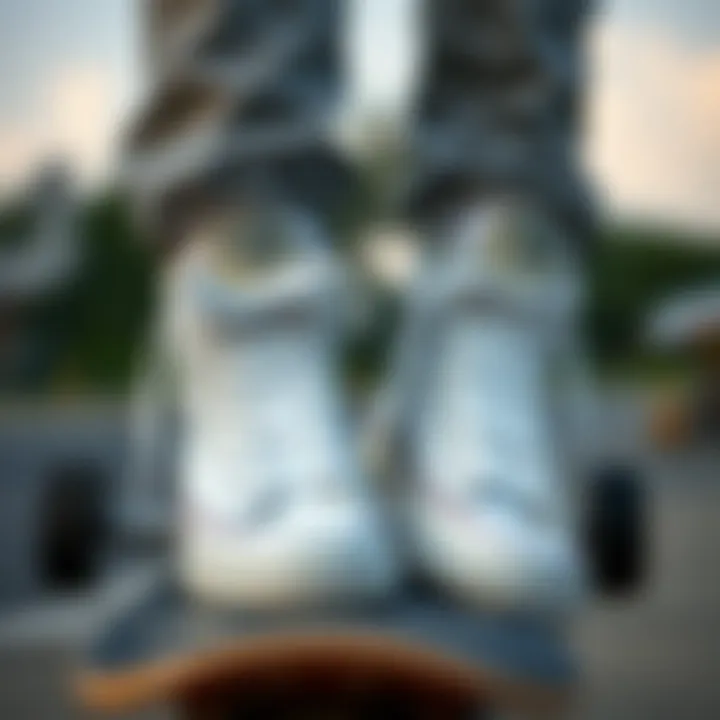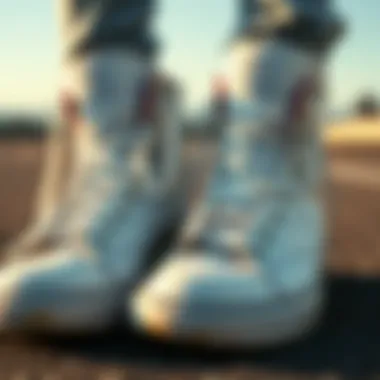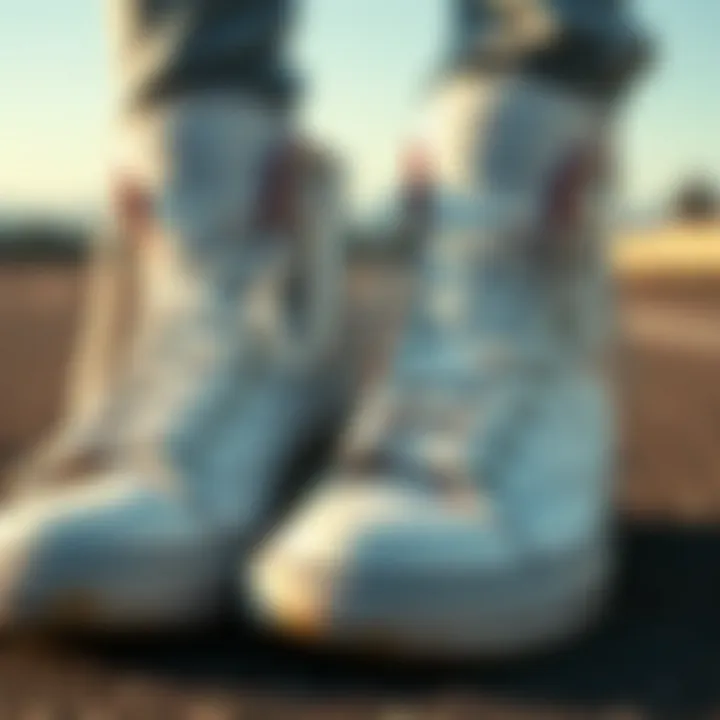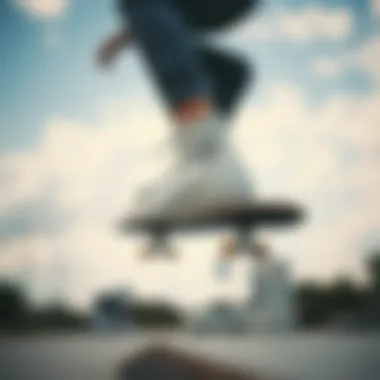The Enduring Appeal of White High-Top Shoes in Skate Culture


Intro
In the vibrant realm of skateboarding, the choice of footwear goes beyond mere aesthetics; it encapsulates a culture, a lifestyle, and a personal statement. White high-top shoes, in particular, have carved out their niche within this dynamic scene, becoming synonymous with both comfort and style. They evoke a sense of nostalgia while also representing an enduring symbol of rebellion and creativity.
The Cultural Canvas
To truly appreciate the significance of white high-tops in skate culture, one must consider their evolution. Originating in the late seventies and gaining traction in the eighties, these shoes became popularized by influential skateboarders who valued both functionality and flair. Key figures like Tony Hawk and Rodney Mullen sported various high-top styles, showcasing them not only on the ramps but also as a fashion staple on the streets. White high-tops, in particular, stand out for their versatility—easily paired with baggy jeans, cargo shorts, or even board shorts, they create a seamless blend between sport and streetwear.
As skateboarding transitioned from being an underground hobby to a mainstream sport, especially with the inclusion of extreme sports in the Olympics, the visibility of white high-tops extended. They no longer were just a piece of gear; they morphed into a cultural artifact infused with history and significance.
"White high-top shoes are timeless. They connect the past with the present, uniting generations of skaters who share one passion."
Function Meets Fashion
The appeal of white high-top shoes is not limited to their aesthetic value alone. Practicality plays a major role in their popularity. The design provides ankle support, crucial for skaters performing complex tricks and maneuvers. Additionally, with their rubber soles, these shoes offer grip on the board, providing the traction necessary for high-performance skating.
Skateboarders, whether they’re professionals or weekend warriors, often share personal anecdotes highlighting how the right shoes can impact their performance. The experience of board feel—how the shoe interacts with the skateboard—can significantly influence a skater's confidence during unique tricks, whether it's a kickflip or a more advanced maneuver like the 360 flip.
This relationship between the skater and their footwear is symbiotic; as much as the shoes facilitate movement, they also embody the skater's identity, showcasing stylistic preferences and personal flair.
Setting Trends
Today, the trend of white high-tops continues to thrive, with various brands embracing and evolving the style. Companies like Vans, Nike, and Converse have released their take on the white high-top, integrating modern technology for better performance while preserving that classic look. Each model brings its unique twist, appealing to both die-hard enthusiasts and newcomers looking to make their mark in the world of skate.
As skate culture weaves its way into pop culture, the influence of white high-tops extends beyond the skatepark. These shoes are spotted on fashion runways and in music videos, affirming their status as icons of coolness in broader society. Whether on a skateboard or strutting down the streets, white high-tops remain a choice that speaks volumes, embodying both heritage and contemporary flair.
In the upcoming sections, we’ll delve deeper into the specific tricks and techniques that enhance the experience of skateboarding while highlighting the essential gear that complements the iconic white high-tops. Riding the wave of this exploration furthers our understanding of how footwear shapes not just performance, but identity in skate culture.
Historical Context of High-Top Shoes
The roots of high-top shoes run deeper than many might realize, intertwining with socio-cultural movements that shaped not just fashion but also the very essence of self-expression and identity in various subcultures. Understanding the historical context of high-top footwear provides more than a glimpse into trends; it showcases the evolution of societal attitudes towards style, functionality, and freedom of choice. In the skate culture milieu, these shoes have become an emblem, marrying practical benefits with aesthetic sensibilities.
Origin of High-Top Footwear
The journey of high-top shoes starts in the late 19th century when basketball players first donned them on the court. Initially designed for performance, these shoes featured padded collars and canvas materials, providing athletes with the necessary ankle support during vigorous play. Over the years, iconic brands such as Converse and Nike revolutionized the category, popularizing designs that soon escaped the confines of sports arenas to become cultural staples.
As youngsters began to occupy their own spaces—skate parks, curbs, and urban streets—the high-top shoe morphed from its athletic origins into a canvas for personal expression. The 1970s marked a critical juncture; skateboarding was no longer a niche pastime. It emerged as a legitimate subculture infused with artistry, music, and rebellion. High-tops were embraced not merely for their comfort but as a badge of identity. The footwear signified not just a choice but a culture’s aspiration to push boundaries and defy societal norms.
The Evolution of Skateboarding Shoes
As skateboarding collided with punk and street artistry, the footwear evolved—differentiating itself from traditional athletic shoes utilized in basketball or other sports. The late 1970s and early 1980s saw the creation of skate-specific high-tops that catered to the unique demands of skateboarders. Durable stitching, grip-enhancing rubber soles, and reinforced toe caps became essential elements.
Prominent figures in skating began endorsing particular shoe styles, which led to increased media visibility and sales. The likes of Tony Hawk and Steve Caballero endorsed brands that offered not only functionality but also unique interpretations of style. For young skaters, wearing these shoes was akin to donning a uniform—an affirmation of belonging to a community that thrived on innovation and a break from convention.
These shifts have not just mirrored changes in skateboard tricks and techniques but also the social landscapes surrounding skate culture. High-tops in this setting captured more than just a trend; they encapsulated an attitude—daring, free-spirited, and unyielding. Their journey reflects not just the evolution of footwear design but the enduring spirit of a generation that refuses to be boxed in.
“High-tops are more than just shoes; they’re a stepping stone into a world where you can express who you truly are.”
By understanding the historical context of high-top shoes, one can appreciate their significance in skate culture—not just as a style choice, but as a vital component of skaters’ identities and their narratives.
Design Elements of White High-Top Shoes
The design elements of white high-top shoes play a crucial role in delineating their significance within skate culture. These shoes are not merely footwear; they embody a rich blend of functionality, aesthetics, and cultural resonance that speaks volumes to everyone involved in the skating community.
Materials and Construction
White high-tops often feature a cocktail of materials, each contributing to both durability and comfort. Synthetic leather, canvas, and mesh are the most prevalent choices. The combination isn’t arbitrary; instead, it caters to specific needs of skateboarders. For instance, synthetic leather offers resistance to scuffs, keeping the shoes looking fresh despite the rigorous activity.
Moreover, padding plays an indispensable role in providing support, particularly around the ankle. This heightened cushioning allows skaters to navigate rough terrains without the fear of injury. Certain models utilize reinforced stitching to prevent wear and tear, extending the life of the shoes. This meticulous attention to construction ultimately enhances performance on the board, making such design choices essential to a skateboarder's toolkit.


Aesthetics and Style Choices
When it comes to aesthetics, white high-top shoes are a blank canvas; they offer a range of style choices that resonate with various subcultures within skateboarding. The clean white surface allows for versatile styling, making it easy for skaters to pair them with everything from baggy jeans to more tailored shorts. This adaptability elevates their status from just functional gear to essential fashion items.
- Customization: Many skateboarders take it upon themselves to personalize their high-tops. Custom spikes, artistic doodles, or mismatched laces can visually represent an individual's skating identity.
- Brand Influence: Major brands like Vans and Converse often introduce unique design elements or collaborations with artists and skateboarders, adding to the appeal.
The visual identity created through these footwear choices fosters a sense of belonging. Skaters often express their individuality and preferences through their footwear, increasing the emotional connection between the community and the high-tops. As a result, white high-top shoes have become symbols of style in skate culture—where every scuff and scratch tells a story.
"In skateboarding, it's not just about the tricks. It's about how you express yourself on and off the board. And it starts from the shoes we wear." - Anonymous Skater
Functional Aspects for Skateboarding
When discussing the role of white high-top shoes in skateboarding, it’s essential to delve into their functional aspects. Unlike some footwear that prioritizes style over substance, skate shoes must stand up to the rigors of the sport. Support, stability, traction, and grip play critical roles in providing skateboarders what they need to perform at their best. Skating isn’t just about looking cool; it’s about functionality and safety while pushing the envelope of creativity.
Support and Stability
Support and stability are pivotal for any skateboarder, particularly during tricks and landings. High-top shoes are renowned for their ability to provide extra ankle support. This feature is especially significant for any skater looking to master complex maneuvers. A sprained ankle can put a damper on one’s skating aspirations, and the right pair of shoes can help mitigate that risk. The design of white high-tops, with their snug fit around the ankle, offers added reassurance when attempting grinds or flips.
The use of materials like leather or synthetic composites in the construction of these shoes also contributes to their stability. The sturdier the shoe, the more confident a skateboarder feels while executing a kickflip or ollie.
Moreover, a well-built high-top shoe minimizes the chances of foot fatigue. After an intense session, tired feet can hinder performance. Thus, reliable support throughout the fabric of the shoe ensures that skateboarders can push through their limitations without feeling as though they’re fighting against their footwear.
"Having a supportive pair of high-tops gave me the confidence to try new tricks without worrying about hurting myself. It’s like having an extra layer of protection."
- A passionate skateboarder’s testimonial.
Traction and Grip
Traction and grip are non-negotiable features for successful skateboarding. The performance of a skateboard shoe largely hinges on its sole's ability to provide a firm grip on the deck. White high-top shoes often incorporate rubber outsoles that deliver exceptional traction on various skating surfaces.
The tread design matters just as much as the material. Shoes that sport a herringbone or cup sole pattern can enhance grip during maneuvers. Every flick and turn needs a secure foot placement, especially during high-risk tricks. If the grip is lacking, skateboarders can easily slip and fall, endangering both themselves and the integrity of their boards.
Moreover, a trustworthy grip enables someone to push off with confidence, gaining enough speed before performing tricks. Without good traction, you might just look cool while waiting for the next wipeout.
When choosing a pair of white high-tops for skating, skaters must consider how various soles interact with their boards. The right shoe makes a world of difference, solidifying the interplay between skater, board, and environment. Without the proper grip beneath your feet, any skater risks stumbling into frustration rather than flowing through their next great ride.
Cultural Significance in Skateboarding
In the vibrant world of skateboarding, the cultural significance of white high-top shoes transcends mere functionality. They embody a deeper connection to the community, transforming everyday apparel into a symbol of identity and expression. Skateboarding is more than just a sport; it is an avenue for creativity and personal freedom. The choice of footwear plays an integral role in how individuals communicate their style and beliefs.
White high-top shoes, in particular, serve not just as a practical choice but also as a profound marker of rebellion against traditional norms. This is a world where conformity has little room, and the rebellious spirit often shines brighter than any polished performance. Whether on the streets or in skate parks, these shoes signal a departure from the mundane and an embrace of individuality.
The simplicity of their design allows for versatility in style, making them suitable for various looks — from casual streetwear to more edgy outfits. By providing the comfort and support needed for skateboarding, they also represent the dual role of functionality and fashion, allowing skateboarders to express themselves fluidly.
"White high-tops are like an unwritten anthem for skaters. They come with a history that connects us to every trick and every fall. It's not just about skateboarding; it’s about being part of something bigger."
As we dive deeper into the heart of skate culture, we must explore specific elements that underline the appeal of these shoes, framed within the context of rebellion and the influence of skating icons who have left indelible marks on this scene.
Symbol of Rebellion and Freedom
White high-top shoes have evolved into much more than plain footwear; they are a badge of defiance. The skateboarding community values creativity, self-expression, and freedom of choice. In many ways, choosing white high-tops reflects a refusal to conform to mainstream fashion standards, instead opting for a style that exudes a sense of authenticity.
Historically, skateboarders have often faced societal backlash, viewed by some as outsiders or nonconformists. The footwear they choose fosters a sense of community, united by a shared ideology that celebrates uniqueness and pushes societal boundaries. When skaters don their white high-tops, they are not just showcasing a brand; they're making a statement—one that stands for liberty and a challenge to the status quo.
These shoes have graced the feet of rebels, artists, and innovators in the skateboarding scene, cementing their status as icons. Each scuff and mark tells a story of failed attempts and triumphant lessons learned, encouraging new generations to embrace their individuality authentically.
Influence of Skating Icons
As much as these shoes stand for individual expression, the influence of skating icons amplifies their cultural weight. Pioneering skaters like Tony Hawk and Doug Dime have incorporated high-tops into their signature styles, showcasing their synergy with the sport. By sporting white high-tops, they didn’t merely focus on the aesthetics but also reinforced the shoes' status as symbols of skate culture.


Through documentaries, interviews, and iconic photos, these skating legends have helped reinforce how closely tied white high-tops are with the daring lifestyle of skateboarders. Their influence extends beyond the ramp; it touches on film, music, and art, embedding white high-tops into larger cultural movements.
In essence, the narratives woven around skating icons highlight the unique relationship between skateboarding and footwear. They shine a spotlight on how certain styles can resonate with the zeitgeist of an era, making white high-tops not just shoes, but a crucial part of skateboarding's evolving identity.
In summation, the cultural significance of white high-top shoes in skateboarding is profound. They serve as symbols of rebellion, embody the spirit of freedom, and remain influential through the contributions of prominent skating figures. Each pair worn tells a story, thereby intertwining personal journeys with the rich tapestry of skate culture.
Current Trends in Footwear
The skateboarding scene is always evolving, influenced by cultural shifts, technological advancements, and, of course, the style preferences of skateboarders. Understanding current trends in footwear is essential not just for enthusiasts, but also for parents, retailers, and new entrants into the skating world. Keeping up with what's hot can affect performance, aesthetics, and even community identity.
Popular Brands in Skateboarding
When it comes to skateboarding shoes, several brands have carved out a permanent niche in the market. Names like Vans, Nike SB, and Adidas often come to mind. Each of these brands brings a unique flair and functionality to their offerings.
With Vans, there's a classic edge that resonates with the roots of skate culture. The authenticity of this brand can’t be denied as they continue to produce designs that have been beloved by skateboarders over decades. Then there's Nike SB, known for constantly innovating, incorporating advanced technologies such as Zoom Air for cushioning and responsive support, which can’t be overlooked during high-impact skating. On the other hand, Adidas captures the essence of classic style while bringing in modern twists, perfect for today’s generation of skaters.
However, it isn't just about the giants. Smaller brands like Chukka or Converse also have their unique positions and followings. They often resonate well with niche audiences looking for something a bit different. These brands reflect not only the skater's taste but their identity as part of a larger movement.
Innovations in Shoe Technology
The landscape of skate shoes is continuously advancing, driven by the desire for performance and comfort. Recent innovations include enhanced grip and lightweight materials that make a world of difference on the board. Some shoes are even now incorporating smart technology. Brands are now testing shoes embedded with sensors that allow the wearer to track their moves and performance metrics through an app. This is quite revolutionary and speaks to the evolving nature of skating.
Additionally, new cushioning technologies significantly reduce the impact on the skater's feet during those high jumps and tricks. For example, some newer models showcase a combination of foam materials that not only provide increased responsiveness but also reduce fatigue over long skating sessions.
There is also an increased focus on sustainability. Brands are starting to incorporate recycled materials into their shoe designs, catering to the eco-conscious consumer who cares about the planet as much as their performance.
Personal Experiences from Skateboarders
Skateboarding isn't just about tricks and ramps; it's woven into the identity of those who love it. For many skateboarders, white high-top shoes symbolize a crucial blend of style and functionality. They don’t merely wear these shoes; they live their lives through them. Personal stories reveal the multifaceted impact these shoes have had on both performance and self-expression within the skating world.
Testimonials on Performance
When skateboarders discuss their experiences with white high-tops, the conversation often steers towards performance. Many agree that the right footwear can be the difference between landing a difficult trick and eating pavement. Take Jake, a local skater known for his impeccable ollies. He swears by his white high-tops, stating, "These shoes give me the right amount of grip and support. I feel like I can conquer the world every time I step on my board."
This sentiment resonates widely. The sturdy construction and supportive design can help prevent ankle injuries, a real concern for those who spend hours practicing their craft. The cushioning in these shoes also absorbs shocks from landing jumps, enhancing the skater's comfort. In fact, a survey conducted among skaters cited comfort as one of the top reasons for choosing white high-tops.
"Good shoes are like a foundation for your tricks. You wouldn't build a house on sand, right?" - Mia, competitive skater.
Stories of Style and Expression
Skateboarding is as much about individuality as it is about skill. White high-tops often serve as a canvas for self-expression. Alex, an amateur skater, recounts how he decorated his pair with stickers and spray paint, transforming them from mere shoes into a reflection of his personality. "Every dent and scratch tells a story about where I've been and what I've done," he reflects, gesturing toward his well-worn footwear.
Customization doesn’t stop at just the appearance; it's a reflection of one's identity in the skate community. The choice of an all-white high-top often signals a minimalist style, making them versatile and easy to pair with various outfits—whether it's baggy jeans or colorful shorts.
In essence, white high-tops are more than just shoes; they are symbols of belonging in a subculture that values uniqueness and creativity. The personal stories shared by skateboarders underscore the shoes’ role as both tools for performance and emblems of style, proving that in the realm of skate culture, every pair tells a different tale.
Maintenance and Care for White High-Tops
Keeping white high-top shoes in tip-top shape is not just about looking good but also about enhancing their longevity and utility in the skateboarding culture. For skateboarders, maintaining their shoes is crucial, primarily because these shoes endure a significant amount of wear and tear during tricks, landings, and street skating. Knowing how to clean and care for these shoes can keep them looking fresh and performing well over time.
Cleaning Techniques
When it comes to white high-tops, cleanliness can be quite a task. If neglected, these shoes can quickly turn into a scuffed canvas of grime. Here are some practical cleaning techniques:
- Daily Maintenance: A soft brush or cloth can make a huge difference. Wiping off dirt and dust regularly prevents buildup that can damage the shoe's fabric.
- Spot Cleaning: For stubborn stains, a mild soap mixed with water could do wonders. Apply it gently with a cloth, and always test a small area before going all in.
- Deep Cleaning: Occasionally, give the shoes a deep clean. Remove the laces and insoles, wash them separately, and use a soft brush or sponge over the shoes. You can even use a mix of baking soda and white vinegar to tackle those pesky spots that just won’t budge.
- Air Drying: After cleaning, avoid the temptation to toss them in the dryer. Air drying preserves the shape and material. Just find a cool, shady spot.
"A clean pair of shoes not only turn heads but can also make you feel good on the board."
Preventing Wear and Tear


While cleaning is important, prevention plays an even bigger role in prolonging the life of white high-tops. Here’s how to fend off wear and tear:
- Choose the Right Fit: Wearing shoes that are too tight can cause them to wear thin at the seams. Ensuring the right fit helps avoid unnecessary stress on the material.
- Skate with Awareness: Being mindful of your skating environment and avoiding rough surfaces can minimize damage. If you know a spot is abrasive, maybe save those high-tops for smoother streets.
- Protective Sprays: Consider applying a water and stain-repellent spray made for sneakers. This forms a barrier against moisture and dirt, which, in the long run, can save you from tougher cleaning.
- Rotate Your Shoes: If you skate frequently, having a rotation of several pairs can significantly extend their life. This way, each pair gets some downtime to recover from your stunts.
Understanding these maintenance techniques not only keeps those kicks looking fresh but also solidifies their place in skate culture as enduring footwear. A well-cared-for pair of high-tops is a testament to both style and functionality.
Comparative Analysis of Various Styles
When delving into the world of skateboarding footwear, a comparative analysis of various shoe styles becomes crucial. This examination not only highlights individual preferences but also illuminates how different types of shoes impact skating performance and overall culture. The choice between high-top and low-top shoes, for instance, is not merely a matter of aesthetics; it's a decision shaped by factors such as support, stability, and personal expression. By exploring these distinctions, we gain deeper insights into the mindset of skateboarders and their connection to the gear they choose.
High-Top vs. Low-Top Shoes
High-top shoes have long been associated with skate culture, offering specific benefits that cater to the needs of skateboarders. The added ankle support from a high-top model can be a game-changer for those attempting tricks that demand stability. Such shoes often envelop the ankle, providing a fortified feeling that instills confidence during high-risk maneuvers.
- Support: High-tops are celebrated for their ability to brace the ankle, minimizing the risk of sprains. This feature is particularly valuable for beginners or those practicing new tricks, where the likelihood of falls increases.
- Protection: The extra height can also shield the ankle from impact, which is common during hard landings on the board. In environments laden with concrete ramps and rough surfaces, high-tops serve as a protective barrier.
- Weight: On the flip side, some skateboarders find that high-tops can feel heavier. This added weight may hinder the nimbleness required for executing rapid tricks and spins, prompting a preference for the lighter, more streamlined low-tops.
Low-top shoes, on the other hand, appeal to those who prioritize freedom of movement. The primary benefits include:
- Agility: Without the bulk of a high-top, low-tops enable quicker foot movements, allowing skaters to pivot and rotate with ease. This can be especially important in street skating, where agility is paramount for avoiding obstacles.
- Breathability: Often constructed from lighter materials, low-tops can be more breathable. This can keep feet cooler during prolonged sessions, which is a significant comfort factor.
- Style: Low-tops tend to come in various sleek designs, making them popular among those who want to make more of a fashion statement.
Ultimately, choosing between high-tops and low-tops boils down to personal skating style, the type of terrain skated on, and preference for support versus mobility. What's clear is that both styles have carved out essential roles in skate culture, influencing how skateboarders express themselves through their footwear.
The Role of Color in Skate Culture
Color in skate culture is pivotal, serving as an expression of individual identity and community. White high-top shoes stand out as a canvas for personal expression within this culture. The choice of color can often symbolize affiliation, style, and attitude, resonating deeply with those who wear them.
- Symbolism: For many, white signifies purity and simplicity, setting a stark contrast against the vibrant colors typically associated with skateboards and gear. This contrast can convey a bold statement about a skater's approach to style.
- Versatility: White high-tops can be paired with virtually any outfit, from classic denim to more eclectic streetwear options. This versatility enhances their appeal, prompting skateboarders to opt for them in diverse situations beyond skating, further cementing their cultural significance.
- Maintenance of Image: Though white shoes can be hard to keep pristine, this challenge adds an element of authenticity among skateboarders. The scuffs and dirt tell a story of experience, connecting the wearer to their journey on the board.
In summary, comparing high-tops and low-tops, alongside the importance of color, provides a rich lens through which we can understand skate culture's evolution. It reveals the nuanced decisions skateboarders make daily, impacting not just how they perform but also how they connect to their identity and community.
Impact on Skateboarding Community
The skateboarding community is more than a group of individuals riding boards; it’s a vibrant tapestry woven from culture, style, identity, and shared experiences. At the heart of this scene lie the iconic white high-top shoes, which do far more than serve as mere footwear. They embody a collective identity that resonates across various demographics, from seasoned skaters to newcomers. Their appeal goes beyond aesthetics; they are a unifying symbol of a lifestyle that values freedom, creativity, and a bit of rebellion.
Collective Identity Through Fashion
Fashion in the skateboarding world acts like a badge of honor. White high-top shoes have managed to carve an indelible niche within this realm. They’re often seen as a rite of passage for aspiring skaters, marking the transition from outsider to part of a community. The unique design and color lend themselves well to self-expression, whether in the urban environment or at skate parks.
One first pulls a pair of white high-tops on, it’s like stepping into a new persona. Many skaters experience a sense of empowerment and camaraderie. The shoes serve as a statement, showcasing an affinity for the culture. Unlike other footwear, they can be personalized with custom laces or even drawn-on designs, adding layers of individuality. Skaters don't just wear them; they make them theirs.
“It’s not just about the tricks; it’s the whole vibe you give off. My white high-tops are a part of who I am.”
– Anonymous Skateboarder
This collective identity is not merely limited to aesthetics. While skating, individuals exchange stories, tips, and even footwear spots. They have each other's backs both on and off the board. The social fabric of skating often extends to local shops or skate meet-ups, where the shared love for white high-tops is sometimes a conversation starter or the common ground that brings folks together.
Footwear in Competitive Settings
In competitive arenas, the significance of white high-tops elevates further. Here, they become performance-enhancing tools that blend style and functionality. Many competitions now recognize that a skater’s choice of footwear can directly influence their tricks, performances, and even how they are perceived by judges and fans alike.
For instance, skaters often get sponsorships based on their footwear choices. A visible connection to well-respected brands not only boosts prestige but can also win over public admiration. With the rise of social media platforms like Instagram and TikTok, showcasing incredible skateboarding skills while sporting the latest designs of white high-tops has become a form of art. Watching a competitor land an impossible trick in these shoes does wonders for both their personal brand and the brand that supports them.
This convergence of fashion and functionality emphasizes the importance of choosing the right footwear in competitive settings. Skaters have begun to focus not only on comfort and grip but also on how their choice of shoes can speak volumes about their personal style, attitudes, and even strategies in competition.
Closure
In wrapping up the discussion about white high-top shoes in skate culture, it becomes clear that their significance goes beyond mere aesthetics. These shoes have woven themselves into the very fabric of skateboarding throughout the years. As we delve into their journey, we recognize that they symbolize a blend of function, style, and cultural identity.
Summarizing the Journey of White High-Tops
The journey of white high-tops can be traced back to their practical beginnings, designed for support during intense activities. They evolved alongside skateboarding, adapting to the style and needs of skaters both in form and function. Points of interest include:
- Functionality: White high-tops provide the ankle support necessary for tricks and stunts, helping skateboarders maintain balance. Some of the shoes featured padded tongues and collars, enhancing comfort and providing a snug fit.
- Cultural Resonance: From their association with music icons to street art, white high-tops have become a cultural symbol. Skateboarders often view them as more than footwear; they represent a form of self-expression and identity within the community.
- Versatility: While primarily skate shoes, white high-tops have transitioned into everyday wear. They complement a wide array of styles, making them a staple not just on the ramps but also on the streets. Even older skaters, upon reflecting, notice how these shoes have always crossed boundaries, appealing to various generations.
As skateboarding continues to evolve, white high-tops remain an enduring choice for many, reflecting personal style while also complying with the demands of the sport. Looking ahead, they might undergo further reimagining in terms of design or technology, but their core essence will likely endure. Whether you are a seasoned skater or a newcomer, understanding the implications of choosing white high-tops can lead to a deeper appreciation of not just the shoes themselves, but the culture surrounding them.
Ultimately, white high-tops serve as an emblem of skate identity, uniting the community while also providing individuals the means to express themselves. Their lasting appeal is a testament to their role in this dynamic subculture, one whose history is both rich and ongoing.



